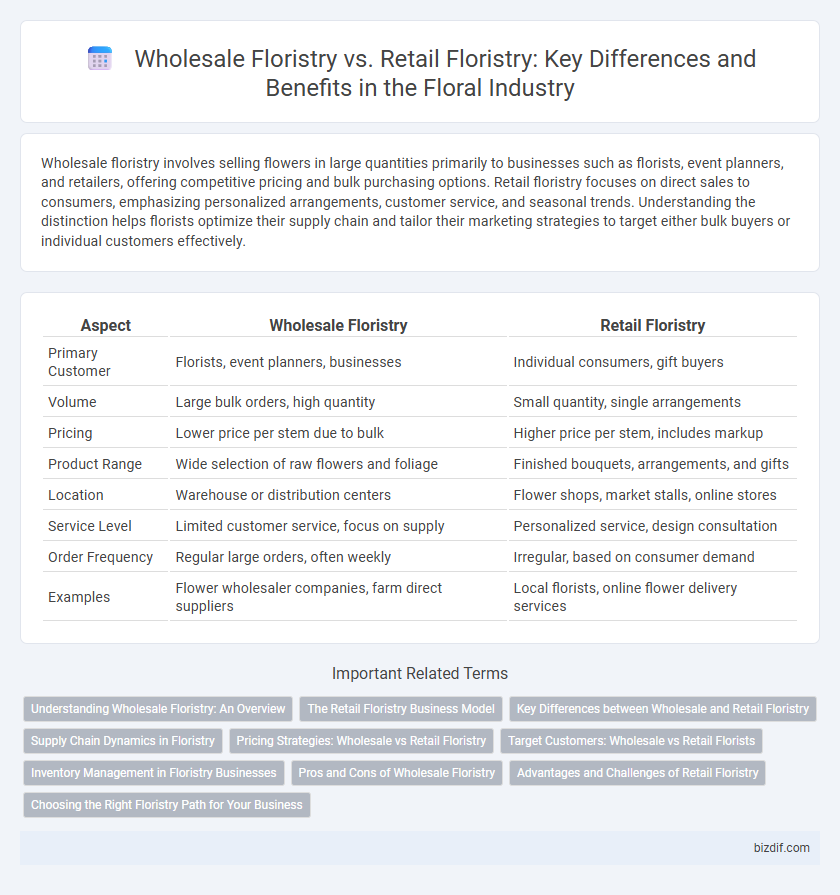Wholesale floristry involves selling flowers in large quantities primarily to businesses such as florists, event planners, and retailers, offering competitive pricing and bulk purchasing options. Retail floristry focuses on direct sales to consumers, emphasizing personalized arrangements, customer service, and seasonal trends. Understanding the distinction helps florists optimize their supply chain and tailor their marketing strategies to target either bulk buyers or individual customers effectively.
Table of Comparison
| Aspect | Wholesale Floristry | Retail Floristry |
|---|---|---|
| Primary Customer | Florists, event planners, businesses | Individual consumers, gift buyers |
| Volume | Large bulk orders, high quantity | Small quantity, single arrangements |
| Pricing | Lower price per stem due to bulk | Higher price per stem, includes markup |
| Product Range | Wide selection of raw flowers and foliage | Finished bouquets, arrangements, and gifts |
| Location | Warehouse or distribution centers | Flower shops, market stalls, online stores |
| Service Level | Limited customer service, focus on supply | Personalized service, design consultation |
| Order Frequency | Regular large orders, often weekly | Irregular, based on consumer demand |
| Examples | Flower wholesaler companies, farm direct suppliers | Local florists, online flower delivery services |
Understanding Wholesale Floristry: An Overview
Wholesale floristry involves purchasing flowers and floral supplies in large quantities directly from growers or distributors, enabling significant cost savings compared to retail prices. This sector primarily serves retailers, event planners, and designers who require bulk orders to meet diverse customer demands efficiently. Understanding wholesale floristry is essential for thriving in the flower industry, as it impacts supply chain dynamics, pricing strategies, and inventory management.
The Retail Floristry Business Model
The retail floristry business model centers on direct sales to consumers, offering customized floral arrangements and personalized customer service. Retail florists maintain physical storefronts or online shops where they source flowers from wholesalers, ensuring fresh, diverse inventory for clients. Profit margins in retail floristry rely on premium pricing, creative design services, and seasonal promotions to attract and retain customers.
Key Differences between Wholesale and Retail Floristry
Wholesale floristry deals primarily with bulk sales of flowers and floral supplies to businesses such as retailers, event planners, and florists, offering lower prices per unit due to higher volume transactions. Retail floristry focuses on selling individual floral arrangements and plants directly to the end consumer, emphasizing personalized service, custom designs, and immediate purchase convenience. Key differences include pricing structure, customer base, order volume, and the level of customization in floral products.
Supply Chain Dynamics in Floristry
Wholesale floristry operates with bulk purchasing and distribution, enabling florists to access large volumes of fresh flowers at lower costs, significantly influencing supply chain efficiency and inventory turnover. Retail floristry focuses on direct consumer sales, requiring frequent restocking and agile supply management to maintain freshness and variety in storefront displays. The interplay between wholesale suppliers and retail florists drives the demand forecasting, logistics coordination, and quality control essential for sustaining a responsive and cost-effective floristry supply chain.
Pricing Strategies: Wholesale vs Retail Floristry
Wholesale floristry typically employs volume-based pricing strategies that offer significant discounts per stem, allowing florists to purchase larger quantities at lower costs. Retail floristry, however, incorporates markups to cover overhead expenses, labor, and customer service, resulting in higher per-stem prices. Understanding the cost structure differences helps florists optimize profit margins while maintaining competitive pricing across wholesale and retail markets.
Target Customers: Wholesale vs Retail Florists
Wholesale floristry primarily targets business customers such as event planners, large-scale florists, and retailers who purchase flowers in bulk at lower prices for resale or event use. Retail florists focus on individual consumers and small businesses seeking customized floral arrangements, gifts, and occasional purchases. Understanding the distinct needs of wholesale clients, including volume discounts and delivery schedules, versus the personalized service and variety demanded by retail customers is essential for success in the floristry market.
Inventory Management in Floristry Businesses
Wholesale floristry manages large volumes of fresh flowers, requiring advanced inventory tracking systems to minimize spoilage and optimize supply chain efficiency. Retail floristry focuses on maintaining a balanced inventory mix of popular and seasonal blooms to meet customer demand while reducing waste. Implementing real-time inventory management software enhances stock accuracy and ensures timely restocking in both wholesale and retail floristry operations.
Pros and Cons of Wholesale Floristry
Wholesale floristry offers significant cost advantages by purchasing flowers and supplies in bulk, enabling florists to maintain competitive pricing and higher profit margins. Bulk buying requires substantial upfront investment and storage facilities to preserve flower freshness, which can increase operational complexity and risk of waste. Access to a broad variety of seasonal flowers through wholesale channels enhances creative options but demands efficient inventory management to balance supply and demand.
Advantages and Challenges of Retail Floristry
Retail floristry offers direct interaction with customers, allowing for personalized floral arrangements that meet specific preferences and occasions. It enables florists to build brand loyalty and showcase creative skills, fostering repeat business through unique, customized designs. Challenges include managing fluctuating demand, inventory perishable items, and higher overhead costs compared to wholesale operations.
Choosing the Right Floristry Path for Your Business
Wholesale floristry supplies large quantities of fresh flowers and foliage at lower prices, ideal for businesses targeting event planners, florists, or retailers seeking volume discounts. Retail floristry focuses on selling individual bouquets and arrangements directly to consumers, emphasizing personalized service, creativity, and local market trends. Selecting the right path depends on your business model, target customers, and growth strategy within the floral industry.
Wholesale floristry vs Retail floristry Infographic

 bizdif.com
bizdif.com